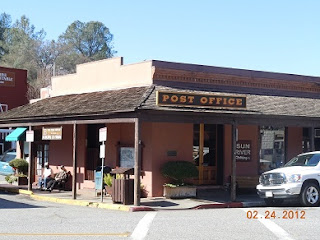 |
| Ken Fox Miner statue in Old Town Auburn |
Auburn, at an elevation of 1,300 feet, like so many California towns in the Sierra Nevada foothills, has a rich history stemming from the wild Gold Rush days.
Auburn was one of California's very first mining towns. It's a must stop when vacationing in the northern California gold country.
A Tour of Auburn California
The photo at left is a 45 ton concrete statue of a Gold Rush era miner. You can't miss it since it stands at the entrance to Old Town Auburn. This statue is one of several created by an Auburn dentist by the name of Ken Fox during the 1970's. The method of constructing this statue is interesting since it was made of a rebar and wire mesh framework covered in concrete.While driving around Auburn you will no doubt happen upon more of Fox's creations including a statue named "The Chinese Coolie".
One of the most interesting things about the towns that sprang up from the 1849 gold rush, and Auburn was one of them, was that they started as mere camps. In many instances, camps with totally different names from what they're called today. In the case of Auburn, in 1848 it's very first name was North Fork Dry Diggings. The next name of this camp was Woods Dry Diggings. These 'diggings" were small camps which evolved into full scale mining camps. The next step after that was to become a town. In August of 1849, the name Auburn was officially proclaimed for this site.
As the years progressed, Auburn happened to be in the right place at the right time during the great California Gold Rush. Auburn was a very important community for several reasons. The Central Pacific Railroad, which ended up later as the westernmost segment of the transcontinental railroad passed right through the town beginning in 1865. The transcontinental route became connected in 1869. In addition to this, Auburn was selected as the county seat of Placer County California, was an active trading post and was a stop on the California Stagecoach route.
Auburn Historic Sites
 |
| Historic Auburn post office |
The post office in this photo is located in Old Town Auburn. A man by the name of William Gwynn, who was running a general store at this site in Auburn, opened the first Post Office at his store in 1852. The structure was built directly over a branch of the Auburn Ravine which was a very active area for placer mining prior to the town being established.
 |
| Old Auburn California firehouse |
The firehouse was home for the Auburn Hook and Ladder Company which started as far back as 1852. The original bell used to sound the alarm and bring volunteers is still in this building. The firehouse was originally located right where Interstate 80 now runs and was moved to the Old Town site.
The firehouse was in operation all the way to 1954. The old Queen Ann design firehouse has been included on the National Register of Historic Places and is a part of California Gold Rush history.
Continuing a tour through Old Town Auburn, one of the most recognized historic buildings is the Auburn Courthouse. The courthouse was built between 1894 and 1898. There was some concern about the building's future in the 1980's because of deterioration from age but thankfully the funds were raised to restore it. Today, the first floor of the Auburn Courthouse is the home of the Placer County Museum. As you can see from the photo, the courthouse is a very impressive structure.
The History of Old Town Auburn
 |
| Auburn Courthouse |
Mining continued to be Auburn's major industry through most of the 1880's. After that, work on the Southern Pacific Railroad, farming and timber harvesting were the economic drivers.
Today, in Old Town you'll find some unique Auburn dining choices, interesting shops and plenty of historic markers. Be sure to bring your camera. Plenty of unique photo ops.
California State Route 49 passes through Auburn as well as numerous other historic old California mining towns and is a route you do want to add to your vacation itinerary if at all possible. In many ways it was the old gold rush trail.
Highway 49 is aptly numbered after the "49ers". These were the thousands of immigrants who swarmed into the area searching for gold. A portion of State Route 49 is named the Gold Country Highway. When you drive Highway 49 north out of Auburn you will want to stop at both Grass Valley California and Nevada City California, both significant old gold mining communities and both very interesting and scenic tourist stops.
As a historic side note, Nevada City California was the town used to film the popular 2006 TV film, The Christmas Card, written by Joany Kane.
 |
| The Central Pacific Railroad was important to Auburn |
For those traveling from the Bay Area to Reno Nevada, Route 49 will intersect with route 20 which will return you to Interstate 80 near Emigrant Gap. The Route 49 option which includes Grass Valley and Nevada City is well worth the extra time.
Emigrant Gap itself is quite historic since it received it's name by being a low gap on a ridge where the emigrants' wagons crossed from the American River drainage to the Bear River drainage. This was a part of the Truckee Route which was part of the famous California Trail. This was the major route of pioneers heading west to California off of the Oregon Trail. Emigrant Gap is just a short way west of Donner Pass. You'll be certain to get some great pictures on this drive.
(Article and photos copyright Western Trips)
View Larger Map

